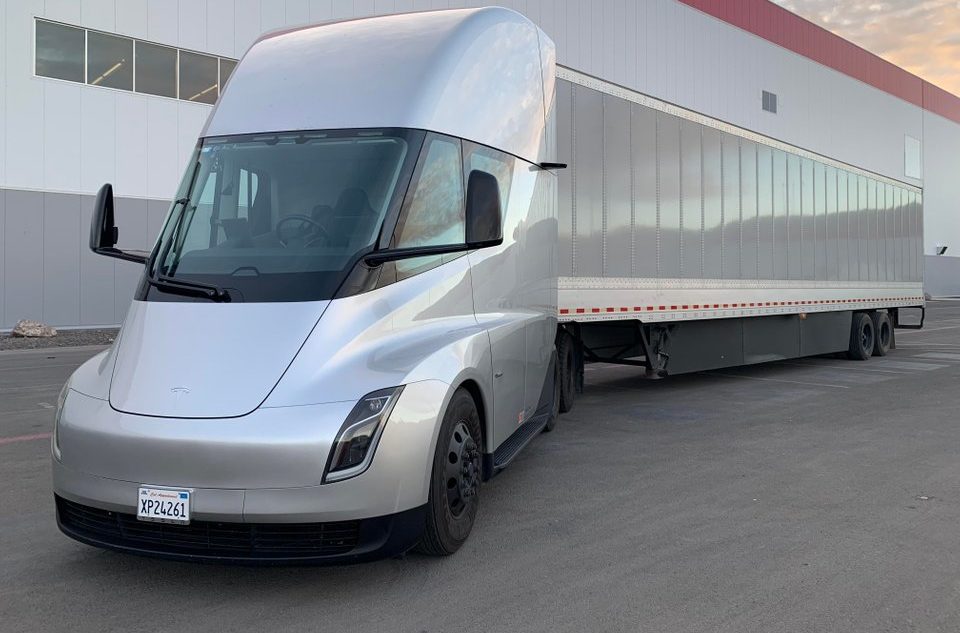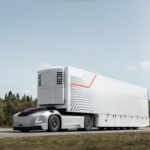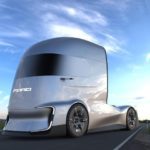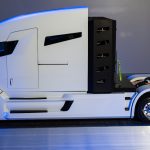

News
The Tesla Semi’s recent Giga 1 sighting highlights its difference from other concept trucks
To say that the Tesla Semi ruffled some feathers when it was unveiled last year is an understatement. Prior to the reveal of all-electric truck, questions were abounding about its viability as an alternative to conventional diesel-powered long-haulers. Even after the Semi’s specs and performance were announced, the vehicle still attracted a lot of skepticism.
During an event for Daimler’s e-Actos electric truck, for example, the company’s Head of Trucks, Martin Daum, noted that Elon Musk’s claims about the Semi’s 300 and 500-mile range are farfetched. Citing limitations in battery tech, Daum stated that “If Tesla really delivers on this promise, we’ll obviously buy two trucks — one to take apart and one to test because if that happens, something has passed us by. But for now, the same laws of physics apply in Germany and in California.” Jon Mills, a spokesman for engine maker Cummins Inc. noted back in August that while electrification is in the future of the trucking industry, the vehicles are not viable in their current state.
Since it was unveiled, the Tesla Semi has been spotted traveling across the United States. Tesla unveiled two working prototypes of the Semi – one painted silver and the other matte black – when it unveiled the vehicle, and so far, both have been spotted testing on US roads. Both trucks were also sighted delivering cargo from Gigafactory 1 in NV to the Fremont factory in CA. Most recently, the silver Tesla Semi was sighted in Gigafactory 1, hauling a trailer and seemingly ready to transport cargo.

Tesla is not the only manufacturer coming up with a zero-emissions truck. As the transport industry starts accelerating its shift towards electrification, even prominent truck companies are coming up with their own green vehicles. Most of these vehicles exist as concepts for now, but they do give an idea of how veteran truckmakers are approaching the industry’s transition to the electric age.
Ford, for one, recently revealed the F-Vision concept, which is loaded to the teeth with cutting-edge tech, including an adaptable windshield that can lower and rise depending on the driver’s preference, as well as front lights that can be fully customized. Last month, Volvo introduced the Vera, its next-generation semi-trailer concept. Unlike Tesla and Ford’s truck, Volvo’s vehicle does not even have a driver’s cabin, as it is designed fully for autonomy. Startup trucking companies are also showcasing their offerings. Nikola Motors, for one, made headlines when it unveiled its long-range sleeper hydrogen-electric truck – the Nikola One – back in December 2016, and the company has since teased its next offering, a day cab called the Nikola Two.
There is little doubt that the upcoming electric truck concepts that have been unveiled so far are exciting vehicles in their own right. Inasmuch as this is the case, though, many of these impressive concepts feature technology that is still yet to be developed or refined. During the F-Vision’s unveiling, for one, Ford clarified that the truck is strictly a concept for now. Volvo’s Vera is a perfect fit for short-haul trips thanks to its 300 kWh battery that gives it a 187-mile range, but the vehicle can’t be deployed anytime soon since self-driving tech is still under development (even autonomous tech leader Waymo is reportedly struggling with its fleet’s real-world testing). Nikola’s hydrogen-electric trucks are powerful and boast long-range, but they would need a network of H2 refilling stations before they can be a viable alternative to diesel trucks. As a result, most zero-emissions truck concepts, including the Nikola One prototype, are yet to be sighted doing real-world tests on public roads.
- The Volvo Vera. [Credit: Volvo]
- The Ford F-Vision concept. [Credit: Ford]
- The Nikola One
This is where the Tesla Semi is different. Among the upcoming electric trucks in the market, the Semi is the one undergoing consistent, intensive real-world testing. The vehicle has been spotted in multiple states since its unveiling, at times even visiting the sites of reservation holders like UPS, J.B. Hunt and PepsiCo. As it conducts its extensive real-world tests, the vehicle undergoes a consistent process of improvement. This was highlighted by Tesla’s Head of Automotive Jerome Guillen during the Q2 2018 earnings call, when he stated that several improvements have already been introduced to the electric truck since it was unveiled last year. Elon Musk even teased on Twitter that the Semi would likely have closer to 600 miles of range per charge. With this, it seems safe to infer that the production version of the Tesla Semi would be better than the prototype that is currently traveling across the country today.
The Tesla Semi balances its features without overdoing it as well. It does not have the cloud-based autonomy of concepts like the Vera or the flashy variable front design of the Ford F-Vision, but ultimately, it does not need to have all these extra bells and whistles to become effective at what it’s designed to do. Tesla created the Semi to be a viable alternative to diesel-powered long-haulers, and if recent sightings and its consistent road tests is any indication, it appears that the vehicle is poised to be exactly that.
The Tesla Semi is expected to start production sometime in 2019. Recent reports have indicated that Tesla is planning on “earnestly” producing the Semi sometime in 2020.

Elon Musk
Elon Musk’s X will start using a Tesla-like software update strategy
The initiative seems designed to accelerate updates to the social media platform, while maintaining maximum transparency.

Elon Musk’s social media platform X will adopt a Tesla-esque approach to software updates for its algorithm.
The initiative seems designed to accelerate updates to the social media platform, while maintaining maximum transparency.
X’s updates to its updates
As per Musk in a post on X, the social media company will be making a new algorithm to determine what organic and advertising posts are recommended to users. These updates would then be repeated every four weeks.
“We will make the new 𝕏 algorithm, including all code used to determine what organic and advertising posts are recommended to users, open source in 7 days. This will be repeated every 4 weeks, with comprehensive developer notes, to help you understand what changed,” Musk wrote in his post.
The initiative somewhat mirrors Tesla’s over-the-air update model, where vehicle software is regularly refined and pushed to users with detailed release notes. This should allow users to better understand the details of X’s every update and foster a healthy feedback loop for the social media platform.
xAI and X
X, formerly Twitter, has been acquired by Elon Musk’s artificial intelligence startup, xAI last year. Since then, xAI has seen a rapid rise in valuation. Following the company’s the company’s upsized $20 billion Series E funding round, estimates now suggest that xAI is worth tens about $230 to $235 billion. That’s several times larger than Tesla when Elon Musk received his controversial 2018 CEO Performance Award.
As per xAI, the Series E funding round attracted a diverse group of investors, including Valor Equity Partners, Stepstone Group, Fidelity Management & Research Company, Qatar Investment Authority, MGX, and Baron Capital Group, among others. Strategic partners NVIDIA and Cisco Investments also continued support for building the world’s largest GPU clusters.
News
Tesla FSD Supervised wins MotorTrend’s Best Driver Assistance Award
The decision marks a notable reversal for the publication from prior years, with judges citing major real-world improvements that pushed Tesla’s latest FSD software ahead of every competing ADAS system.

Tesla’s Full Self-Driving (Supervised) system has been named the best driver-assistance technology on the market, earning top honors at the 2026 MotorTrend Best Tech Awards.
The decision marks a notable reversal for the publication from prior years, with judges citing major real-world improvements that pushed Tesla’s latest FSD software ahead of every competing ADAS system. And it wasn’t even close.
MotorTrend reverses course
MotorTrend awarded Tesla FSD (Supervised) its 2026 Best Tech Driver Assistance title after extensive testing of the latest v14 software. The publication acknowledged that it had previously criticized earlier versions of FSD for erratic behavior and near-miss incidents, ultimately favoring rivals such as GM’s Super Cruise in earlier evaluations.
According to MotorTrend, the newest iteration of FSD resolved many of those shortcomings. Testers said v14 showed far smoother behavior in complex urban scenarios, including unprotected left turns, traffic circles, emergency vehicles, and dense city streets. While the system still requires constant driver supervision, judges concluded that no other advanced driver-assistance system currently matches its breadth of capability.
Unlike rival systems that rely on combinations of cameras, radar, lidar, and mapped highways, Tesla’s FSD operates using a camera-only approach and is capable of driving on city streets, rural roads, and freeways. MotorTrend stated that pure utility, the ability to handle nearly all road types, ultimately separated FSD from competitors like Ford BlueCruise, GM Super Cruise, and BMW’s Highway Assistant.
High cost and high capability
MotorTrend also addressed FSD’s pricing, which remains significantly higher than rival systems. Tesla currently charges $8,000 for a one-time purchase or $99 per month for a subscription, compared with far lower upfront and subscription costs from other automakers. The publication noted that the premium is justified given FSD’s unmatched scope and continuous software evolution.
Safety remained a central focus of the evaluation. While testers reported collision-free operation over thousands of miles, they noted ongoing concerns around FSD’s configurable driving modes, including options that allow aggressive driving and speeds beyond posted limits. MotorTrend emphasized that, like all Level 2 systems, FSD still depends on a fully attentive human driver at all times.
Despite those caveats, the publication concluded that Tesla’s rapid software progress fundamentally reshaped the competitive landscape. For drivers seeking the most capable hands-on driver-assistance system available today, MotorTrend concluded Tesla FSD (Supervised) now stands alone at the top.
News
Elon Musk’s Grokipedia surges to 5.6M articles, almost 79% of English Wikipedia
The explosive growth marks a major milestone for the AI-powered online encyclopedia, which was launched by Elon Musk’s xAI just months ago.

Elon Musk’s Grokipedia has grown to an impressive 5,615,201 articles as of today, closing in on 79% of the English Wikipedia’s current total of 7,119,376 articles.
The explosive growth marks a major milestone for the AI-powered online encyclopedia, which was launched by Elon Musk’s xAI just months ago. Needless to say, it would only be a matter of time before Grokipedia exceeds English Wikipedia in sheer volume.
Grokipedia’s rapid growth
xAI’s vision for Grokipedia emphasizes neutrality, while Grok’s reasoning capabilities allow for fast drafting and fact-checking. When Elon Musk announced the initiative in late September 2025, he noted that Grokipedia would be an improvement to Wikipedia because it would be designed to avoid bias.
At the time, Musk noted that Grokipedia “is a necessary step towards the xAI goal of understanding the Universe.”
Grokipedia was launched in late October, and while xAI was careful to list it only as Version 0.1 at the time, the online encyclopedia immediately earned praise. Wikipedia co-founder Larry Sanger highlighted the project’s innovative approach, noting how it leverages AI to fill knowledge gaps and enable rapid updates. Netizens also observed how Grokipedia tends to present articles in a more objective manner compared to Wikipedia, which is edited by humans.
Elon Musk’s ambitious plans
With 5,615,201 total articles, Grokipedia has now grown to almost 79% of English Wikipedia’s article base. This is incredibly quick, though Grokipedia remains text-only for now. xAI, for its part, has now updated the online encyclopedia’s iteration to v0.2.
Elon Musk has shared bold ideas for Grokipedia, including sending a record of the entire knowledge base to space as part of xAI’s mission to preserve and expand human understanding. At some point, Musk stated that Grokipedia will be renamed to Encyclopedia Galactica, and it will be sent to the cosmos.
“When Grokipedia is good enough (long way to go), we will change the name to Encyclopedia Galactica. It will be an open source distillation of all knowledge, including audio, images and video. Join xAI to help build the sci-fi version of the Library of Alexandria!” Musk wrote, adding in a later post that “Copies will be etched in stone and sent to the Moon, Mars and beyond. This time, it will not be lost.”











